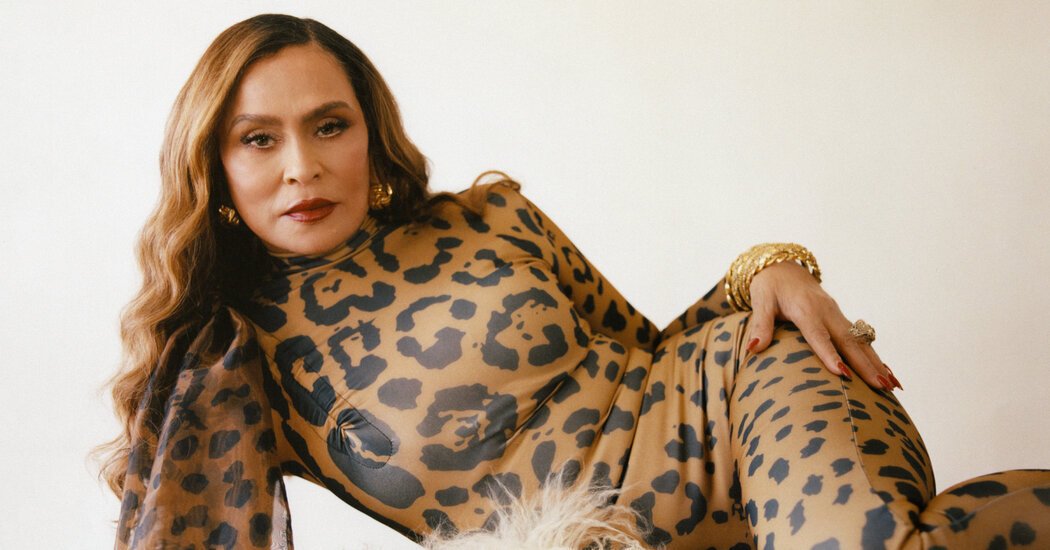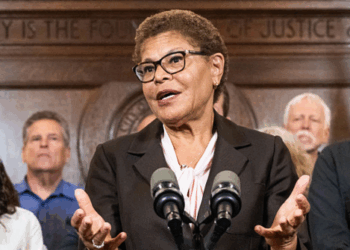A little over a decade ago, during quiet moments traveling between New York and Houston, Tina Knowles started freestyling, recording memories and childhood stories in voice notes on her cellphone.
Then 59, Knowles was still busy styling and mothering her world-conquering daughters Beyoncé and Solange Knowles (she counts Kelly Rowland and a niece, Angie Beyincé, as her own, too) and had just divorced her husband of 31 years. There had been several deaths in her family.
“I just started thinking about mortality, and ‘I’m not gonna be here forever,’” she said. “I felt old, I felt sad.” She wanted to leave a legacy for her kids and grandchildren.
As Knowles, now 71, sat earlier this month in the great room of her home atop a Hollywood Hill, a sunny space filled with gallery-sized artwork at every turn, she described that personal nadir while infrequently waving a hand adorned with a few knuckle-sized gold rings and manicured in a bright red that matched her lipstick. Having changed into a tan Alo sweatsuit after a photo shoot — the right sleeve eventually slipped, leaving her shoulder bare — she radiated an offhand sultriness, a nonchalant glamour that couldn’t have been more removed from the dark era that launched the project.
Her resulting memoir, “Matriarch,” available Tuesday, brings Knowles’s life to center stage. It has the drama of her upbringing in the segregated South and the personal improvement journey of a working mom compelled to stand up for her kids but not herself, as well as cautionary optimism: Knowles reveals for the first time that she was diagnosed with stage 1A breast cancer in 2022. (After surgery and treatment, she is cancer free — and daring to dress in “sheer mesh” after undergoing a reduction. “That was my silver lining.”)
“My kids love me and admire me and all of that, but I think they get a deeper understanding of me, too, and why I did some of the things I did, like stayed so long or whatever,” she said, her Galveston, Tex. drawl creeping through to stretch out kiiiiiiiids and diiiiiiiid. “Once they read this book they’ll understand a lot more.”
In some corners, Knowles is sort of the internet’s mama, regularly filming “corny joke time” clips and sometimes sharing childhood stories and tour insights. Fan armies also lurk for the moments when she unwittingly shares unapproved photos. When “Matriarch” was first announced, Beyoncé showed her support in a post to social media that also came with a caution. “I’m happy for you to share some of the stories that shaped you into who you are,” she wrote. “To know you is to love you. But please don’t spill too much Mama Tea.”
Hers is a famously private clan whose starry progeny, including son-in-law Jay-Z, each explore personal pain and triumphs in their own very deliberately produced art — and rarely elsewhere. Though Knowles had been keeping her voice notes, when she was approached to write a memoir, she initially balked: “They’re going to want to hear about my kids; they’re not going to want to hear about me. That was what I kept saying to myself is don’t nobody want to hear my story.”
She budged, figuring she could compile the innocuous behind-the-scenes bits that have been a hit on her social feeds. Some of those stories remain flecked throughout “Matriarch.” As hairstylist for Destiny’s Child’s first video, “No, No, No (Part 2),” Knowles realized she hadn’t brought enough extensions to set, so she cut blonde streaks off her own head until Beyoncé had a camera-ready look. The promo art for Solange’s debut album, financed in part through her college fund, had Knowles and Stephanie Gayle, then Columbia Records’ vice president of marketing, running to Central Park to use a carriage horse as a free prop.
Those memories often serve another purpose: detailing the uphill battle the whole family fought in pursuit of musical careers. After signing with Columbia, label execs disparaged Destiny’s Child’s homespun styling. “No one got it,” Gayle said in an interview. “Tina was doing the hair. Tina was the clothes. Every, you know, video shoot, everything we did, it was just complaining, complaining, because they just didn’t get it.”
Some of Destiny’s Child’s most iconic looks — think the shredded camouflage of the “Survivor” video — were the result of Knowles’s quick-thinking and the label’s budgetary stinginess. Though the group reeled off No. 1 singles and became one of the best-selling girl groups in history, style budgets kept tightening with the knowledge that Knowles would stay up through the night adding rhinestones or draping fabric. “That’s Tina,” Gayle said. If there was a problem on the road, “she’s gonna pray about it and she’s gonna fix it.”
But instead of strung-together backstage tales, “Matriarch” gets to the root of why Knowles ended up spending all her creative energy on her girls’ careers without saving that glam for herself. And why she stayed in a marriage that, she writes, was challenged by infidelity from the beginning. The book is also the first time she has publicly acknowledged that tension. (Mathew Knowles declined to comment on it, but called their pairing “a great team!” business-wise, in a statement, and confirmed that he had received the parts of the book that reference him ahead of publication.)
Born the youngest of Agnes Buyince’s seven children, Celestine Beyoncé earned the nickname “Badass Teenie B” from older siblings for her headstrong ways and quick lip. (Each new arrival had the surname typed onto their birth certificate in variations including Beyince, Buyince and Beyoncé. Knowles’s mother was told, ‘Be happy you’re getting a birth certificate,’ as many Black people in Galveston, Tex., didn’t always.)
Agnes, Knowles writes, relayed what was known of the family’s history: That both her great-grandmother and grandmother fought to keep their children from being sold away or otherwise separated in slavery. How remains a mystery. Matriarchs, Knowles writes, “are filled with the most enduring and ferocious love.”
Agnes was a seamstress who bartered vestments in exchange for her children’s enrollment in a Catholic elementary where, Knowles writes, the nuns singled her out for punishment (sometimes corporal) because she didn’t belong among the kids of the town’s Black professional class. When Knowles would run back home after she’d been demeaned or hit, her mother would march her back to class to apologize.
“It’s never left me because it just put an indelible mark on my brain and, I’m sure, my self-esteem,” she said in a chatty stream-of-consciousness. “And so on one hand, I was this person that was such a fighter. But on the other hand, I think it shaped my relationships. I think it shaped my self-esteem sometimes that I just wasn’t worthy and you know, I have scars from that that I’ll go to my grave with.”
The ability to beautify things and people, Knowles learned, could be a means of survival and advancement. Opening a bustling Houston hair salon that catered to Black professionals, Knowles dressed her stylists in heels and gave them newspaper articles to read so they could carry on conversations with clients. “That way, even if they didn’t know anything about whatever this lawyer, doctor, or whomever was in there, they were able to talk about current events,” Vernell Keys, a lifelong friend of Knowles’s, said in an interview. “Most of them went on to own their own businesses.”
John Edward Rittenhouse II, the Uncle Johnny who helped inspire Beyoncé’s “Renaissance” (“Uncle Johnny made my dress / that cheap spandex, she looks a mess,” she sings on “Heated”), learned to sew because the older women in the family knew guys couldn’t bully the tailor they needed to make patchwork leather coats and bell bottoms. Knowles took him to his first gay bar and writes warmly of her nephew and best friend, who was protected by his family in ways that many out young Black men have never been.
“To be able to talk about him and to make him a real person other than just somebody who sewed or who influenced my kids to do house music, because that was his thing, that was really wonderful,” she said.
By writing his life alongside hers into the public record, Knowles attempts a profoundly difficult feat for someone so near such massive celebrity: reclaiming the facts of her life as more than just fan service. When she first started digging into internet genealogy sites while researching the book, Knowles couldn’t be sure the information hadn’t been populated by fans. A search for her paternal great-grandmother’s maiden name showed a branch of women who all had Solange as a middle name. Knowles thought she’d stumbled into a fraud.
She asked a researcher to help dig and within minutes he called to say the information was legit. “I texted my girls and Solange texted me back and she was like, ‘Mama, what kind of voodoo Creole mess is this?’”
Knowles’s famous daughters don’t show up until Chapter 15, and her fierce protectiveness of them shapes much of what’s in — and out — of the book. When I suggest that this memoir, with its themes of maternal lineage and revelation about infidelity, made me wonder how her experience may have connected to “Lemonade,” Beyoncé’s album that explores the same topics, Knowles very definitively said, with a smile, “I’m not going to talk about that.”
Despite the public’s insatiable appetite for any morsels about her children, “Matriarch” is resolutely a book about Tina Knowles. “I still think I have some fear too,” about publishing, she said, adding that she sent her children and her exes the passages that mention them by name. “And then I’ve come to, you know, deal with the fact that this is my story.”
And it’s as vivid — and discreet — as she is.
Elena Bergeron is an editor and writer in the Culture section of The Times.
The post Tina Knowles, Mother of Superstars, Owns Her Own Story appeared first on New York Times.




